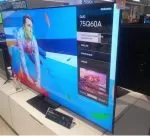
Multymeter.comâElectronic Engineering: Technological developments also include the development of television, a product that almost all families in the world have.
In the past, the TV that circulated was only a type of CRT tv, or better known as tube tv, then times began to change, so there was a new technology to introduce lcd screen tv, this type of tv became a luxury item, so not everyone made an lcd type tv as the main choice, the selection of tube/CRT type tv is still circulating today.
After the era of lcd tv began to develop, there were several types of tv that began to introduce themselves with all the sophistication of their features, starting with digital technology, to support with internet networks, we call them LED, Amoled, OLED, and Qled screen tvs. found in the market with the output of several brands with big names, as well as new brands. Then what are the advantages, and the difference with tube/CRT screen tv, and lcd tv? Here we discuss everything.
1. LCD Screen
LCD type television screens are arranged using crystal liquid, so that the shape is slim and gives an effect on the display, which is more color than CRT tubes. LCD has two important components, namely TFT (Thin Film Resistor) as a canvas/screen and neon cathode as a light source. LCD TVs also use CCFL (Cold Cathode Fluorescent Lamp) as a back light source.
Advantages
- LCD TV doesnât tire your eyes when you watch it
- More efficient electricity consumption
- Easier display settings
- Thin dimensions and light weight make it easy to place.
Minus
⢠LCD TVs are more sensitive to damage.
⢠Limited viewing angle, limited color depth and less color gradation.
⢠Image display is better at its native resolution.
⢠Response time ghosting.
⢠They are more expensive and require extra care.
2.LED Screen
LED screens are actually the same as LCD screens, but LED TV screens have an increased display effect on the colors displayed, namely more color variations, the difference is that LED screens use LED lights as a background light. By using LED lights, it makes the light more evenly distributed and can save electricity consumption by up to 40-70%.
Advantages
⢠Very sharp image contrast up to millions of pixels.
⢠More efficient electricity consumption compared to LCD.
⢠Longer service life of LEDs.
⢠The slimmer size is lighter than the LCD.
⢠Better lighting than LCD.
Minus
⢠The price is more expensive than LCD.
⢠Thinner LED screens tend to be more sensitive.
⢠Treatment is also more difficult.
3.Amoled Screen
AMOLED (Active Matrix Organic LED) is a screen where all the dots (pixels) can produce their own light. Has the ability to emit light which is then captured by a film of organic material. This layer is usually made of polymer materials derived from organic materials. Organic matter stored in rows and columns will form a matrix that can display a different color for each pixel.
4.OLED screen
OLED TV stands for âOrganic Light Emitting Diode TVâ is a light diode (LED) TV in which the emitting electroluminescent layer is a film of organic compounds that emit light in response to an electric current. This layer of organic semi-conducting material is located between the two electrodes. Generally, at least one of the electrodes is transparent. Thus, this technology can display blacks with deeper and brighter colors than liquid crystal displays. In low ambient light conditions such as a dark room, OLED screens can achieve a higher contrast ratio than LCDs, currently OLEDs are mostly developed with curved screens.
Advantages
⢠Thinner than LCD tv.
⢠More energy efficient.
⢠Sharper image.
⢠Since it has no backlight, the black color is perfect.
⢠Has precise color accuracy.
⢠Wider viewing angle than LCD.
Minus
- The price is expensive
5.QLED screen
The QLED screen is a revolution from LED TV, where QLED TV uses Quantum dot technology. QLED TV screens are capable of achieving the highest brightness and color between 1,500 to 2,000 nits.
Advantages
⢠Thinner screen than LED TV.
⢠Color and Contra is better than LED TV.
⢠More energy efficient.
Minus
- Thinner and sensitive screen.
So, how is it ? Have you found the TV option that you will use? But what you need to know is that the sophistication of a TV screen will not be felt if the movie you are watching is of UHF quality or a TV antenna. The difference in image quality will be clearly visible if you watch FULL HD, blue ray, or 4k movies.***
#Television #Lcdscreen #Ledscreen #Oledscreen #Qledscreen #Technology #Tvcrt


